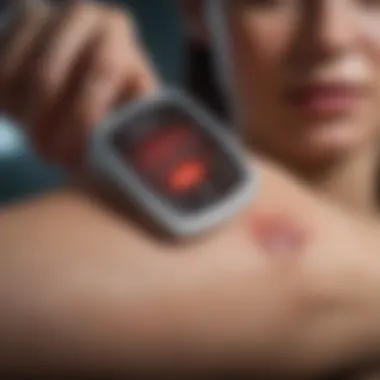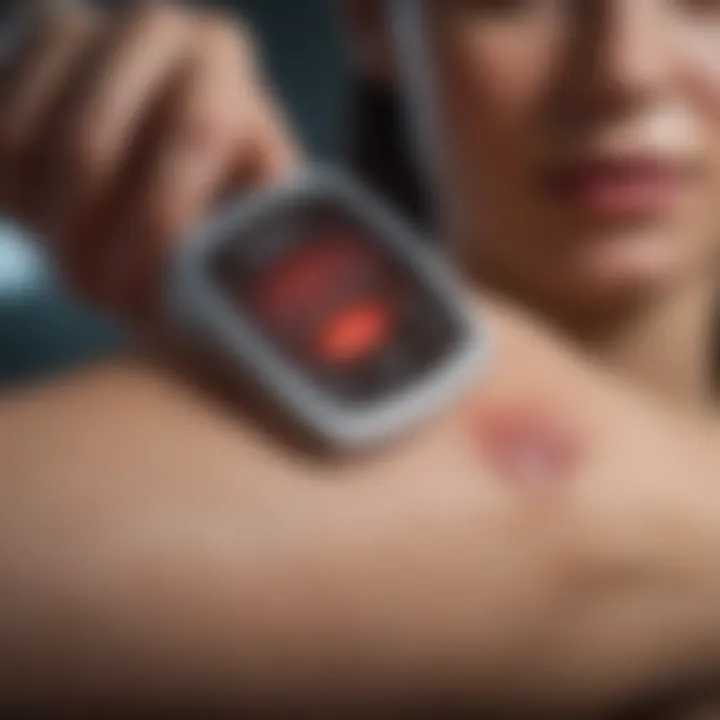Blood Monitor Patch: Innovation in Health Tracking


Intro
Health monitoring is taking a turn for the better, and at the center of this revolution is an innovative device: the blood monitor patch. This small but mighty tool aims to transform how we keep track of our health, particularly concerning blood glucose levels. In an age where technology meets health, this patch might just be what many have been waiting for.
Imagine being able to receive real-time updates on your blood glucose levels without the hassle of traditional finger-prick tests. Sounds almost like something out of science fiction, doesn't it? Yet, here we are, standing on the brink of what could be a major shift in personal health management. This device could seamlessly bridge the gap between medical professionals and patients, offering insights that lead to more informed decisions regarding health.
In the following sections, we will explore the underlying technology of the patch, its numerous applications, and the challenges that accompany such an advancement. We'll also look at how this development fits into the broader landscape of continuous health monitoring. So, let’s dive deeper into this topic.
Prelude to Blood Monitor Patches
Blood monitor patches are emerging as a critical innovation in the realm of health monitoring, reshaping how individuals track their physiological conditions. They blend cutting-edge technology with practicality, making real-time health data accessible to everyday users. With the potential to enhance patient outcomes and contribute to personalized health management, blood monitor patches signify a leap forward in wearable technology.
Historical Context
The journey of health monitoring devices can be traced back to rudimentary approaches, such as the sphygmomanometer for blood pressure and the glucometer for diabetes management. These tools required cumbersome setups and were often limited to clinical settings. It wasn't until the advent of more sophisticated electronics, including microprocessors in the late 20th century, that the concept of continuous monitoring began to take shape.
Wearable technology, however, only truly began to flourish in the 21st century. This shift was fueled by advancements in materials science and miniaturization techniques. Henceforth, strips of silicone and polymers became vessels for intricate sensors, providing both the framework and functionality that paved the way for today’s blood monitor patches.
The Rise of Wearable Technology
The early days of wearable devices were marked by fitness trackers and basic heart rate monitors. As the public’s awareness of health and wellness grew, so too did the demand for more reliable and versatile monitoring solutions. Consumers wanted tools that didn’t just collect data but also interpreted it in a way that could influence daily health decisions.
In this context, blood monitor patches emerged, characterized by their unobtrusive nature and enhanced functionality. Unlike previous heart rate monitors or pedometers, these patches capture complex biological data continuously. They allow for direct engagement with one's health metrics right at their fingertips.
As technology marches forward, the integration of blood monitoring systems into wearable formats stands to play an instrumental role in transforming healthcare into something more dynamic and accessible. An ecosystem where individuals take charge of their health could help reduce the burden of chronic diseases and usher in a new age of personal well-being.
Technical Mechanisms of Blood Monitoring
Understanding the technical mechanisms behind blood monitoring patches is crucial, as they form the backbone of how these devices gather and interpret health data. The innovation in this field not only paves the way for advanced medical insights but also elevates the standard of personalized health care. This section explores the main elements of blood monitoring technology, touching on the components that contribute to its efficiency, reliability, and effectiveness.
Understanding Blood Composition
Blood is a complex mixture, and grasping its composition is fundamental to making sense of how monitor patches operate. Each component plays a significant role in our overall health. Key parts include:
- Red Blood Cells: Essential for oxygen transport.
- White Blood Cells: The body’s defense system against illness.
- Plasma: The liquid medium that carries cells and nutrients.
- Platelets: Vital for blood clotting.
The patch’s ability to assess variables such as glucose levels hinges on understanding these components. For instance, glucose is primarily transported through plasma, and monitoring patches need to evaluate this accurately. Analyzing the syrupy cocktail that is blood gives insight into how effective the patches can be in delivering real-time data regarding a user's health status.
Sensor Technology
Sensor technology is at the heart of blood monitoring patches. It determines how accurately and reliably the patches function. Two of the key types of sensors used are optical sensors and electrochemical sensors.
Optical Sensors
Optical sensors utilize light to determine the concentration of specific substances in the blood. This technology is often seen as non-invasive and user-friendly, a huge plus for daily monitoring. One key characteristic is their ability to measure blood parameters through the skin, thus reducing the discomfort associated with traditional methods like finger pricking.
- Key Feature: Reflective spectroscopy can analyze blood without penetration.
- Advantages: Non-invasive, less painful, and generally more acceptable for regular use.
- Disadvantages: They can be sensitive to motion, and readings may vary based on skin tones and thicknesses.
Electrochemical Sensors
Electrochemical sensors work by applying a small electrical current to the blood sample to identify specific chemical changes. They are critical in continuous glucose monitoring. One of their defining characteristics is high precision in measuring glucose levels, making them a popular choice for diabetes management.
- Key Feature: They provide real-time readings with excellent accuracy.
- Advantages: Reliable data that is useful for immediate feedback, ideal for conditions requiring tight monitoring like diabetes.
- Disadvantages: These sensors can be affected by factors such as temperature and can require regular maintenance to ensure reliability.
Data Transmission and Connectivity
The effective transmission of data is a pivotal aspect of blood monitoring technology. Without robust connectivity, the vast amounts of data collected by these patches wouldn't be useful.
Bluetooth Technology
Bluetooth technology serves as a bridge between the monitoring device and the user’s smartphone or medical devices. This connection enables seamless data sharing and real-time updates. One key characteristic is its capability for low-energy consumption, which is essential for devices that rely on battery life.
- Feature: It can transmit data wirelessly over short distances.
- Advantages: Convenient for users, as it allows continuous monitoring without cumbersome wires.
- Disadvantages: Connectivity issues can arise in areas with poor signals or interference from other devices.
Data Analytics


Data analytics processes the information collected by the patch to provide meaningful insights. It enhances the ability to interpret health trends over time. One key characteristic of data analytics is its ability to personalize feedback, making it tailored for individual user needs.
- Feature: Ability to sift through vast amounts of health data for actionable insights.
- Advantages: Helps in spotting health trends and potential issues earlier, guiding timely healthcare decisions.
- Disadvantages: Requires sophisticated algorithms which could lead to inaccuracies or misinterpretations if not designed carefully.
Applications of Blood Monitor Patches
The integration of blood monitor patches into health monitoring presents numerous possibilities that extend well beyond simple glucose tracking. By continuously gathering real-time data, these patches can fundamentally change how we approach healthcare management across various demographics. The applications are diverse, and their benefits can be monumental. Let's delve into the specific areas where blood monitor patches can make a significant impact.
Diabetes Management
Managing diabetes requires constant vigilance. Blood monitor patches enable individuals to monitor their glucose levels without the hassle of finger prick tests. This continuous monitoring can provide a clearer picture of blood sugar fluctuations throughout the day. The ability to track trends over time means patients can make informed decisions alongside their healthcare providers. Moreover, these patches can alert users in real time when their glucose levels are approaching dangerous thresholds, ensuring timely intervention.
For instance, a 2021 study highlighted a significant reduction in hypo- and hyperglycemic episodes among users of continuous glucose monitoring systems, like blood monitor patches. Such technology not only improves patient adherence to treatment regimens but also enhances quality of life. With the patch, less invasive methods of monitoring empower individuals by taking the medical burden off their shoulders and allowing them to focus more on their lifestyle choices.
Chronic Disease Monitoring
Beyond diabetes, blood monitor patches can serve as critical tools in the comprehensive monitoring of chronic diseases like cardiovascular issues or kidney dysfunctions. These conditions necessitate regular assessment of various biomarkers, and traditional methods often require inconvenient and painful venipunctures. Blood monitor patches simplify this process by tracking relevant data efficiently and painlessly.
Consider hypertension, for instance. Regular blood pressure measurements can significantly help in adjusting medications and lifestyle choices. However, many patients struggle with compliance. A blood monitor patch that integrates blood pressure monitoring can lead to more consistent data, giving healthcare teams the insights required to manage treatment plans effectively.
Fitness and Wellness Tracking
Health and wellness have taken on new meanings in recent years, and many individuals are looking for more information about their health status. Blood monitor patches can act as valuable wellness assistants, tracking not only glucose levels but also hydration status, lactate levels during exercise, and even electrolytes.
Athletes and fitness enthusiasts can benefit immensely from real-time insights into their physiology. This data can inform how one’s body responds to certain workouts, aiding in optimizing performance and recovery periods. Moreover, integrating these patches with other smart devices could lead to a comprehensive health ecosystem for fitness enthusiasts. In essence, users stand to gain actionable insights at their fingertips.
"Continuous monitoring of health vitals is not just about tracking; it’s about empowering individuals to take control of their health choices."
Benefits of Blood Monitor Patches
The advent of blood monitor patches marks a significant evolution in the realm of health monitoring. These devices stand out due to their numerous advantages that cater to individuals with varied needs, from management of chronic conditions to the pursuit of improved wellness. By using a patch that attaches to the skin, users can gain real-time insights into their blood metrics, fundamentally changing how we approach health, not just for the sick but for the healthy as well.
Continuous Monitoring
Continuous monitoring refers to the capability of the blood monitor patch to provide an ongoing assessment of glucose levels, blood composition, or other vital metrics. This constant data stream enables users to gain a deeper understanding of their health status. Traditional methods of testing, such as finger pricks, are often inconvenient, especially for those requiring frequent readings. Here’s what makes continuous monitoring particularly compelling:
- Immediate Feedback: With non-invasive sensors, users can receive alerts about glucose spikes or drops, allowing for quick action and potentially avoiding serious complications.
- Tailored Insights: By analyzing data over time, individuals can learn how different foods, activities, or stress levels affect their readings, empowering them to make informed lifestyle choices.
- Reduced Anxiety: Knowing that they are being monitored consistently, users may feel more at ease, which can lead to better management of their conditions.
This ongoing vigilance aligns closely with personalized healthcare, offering a more proactive approach rather than reactive.
User Convenience
Convenience is a game changer in modern health technology, and the blood monitor patch excels in this regard. The ease of use appeals to a wide range of users, from busy professionals to elderly patients who may struggle with more complex devices. Consider these factors:
- Discreetness: The patch is typically small and can be worn under clothing, allowing users to monitor their health without drawing unwanted attention.
- Hassle-Free Operation: There is no need for cumbersome setups. Applying the patch is straightforward, saving time and reducing the learning curve.
- Integration with Mobile Devices: Most patches sync seamlessly with smartphones or other devices via apps. This not only facilitates easy access to data but also allows users to share information with healthcare providers with a simple tap.
“Convenience in health monitoring can drive adherence to treatment plans, bridging the gap between technology and personal health management.”
Potential for Preventative Care
Preventive healthcare is increasingly recognized as essential in avoiding chronic diseases and promoting longevity. Blood monitor patches have the potential to play an integral role in this aspect of healthcare. Here are some insights on their preventive benefits:
- Early Detection: The continuous data provided by these patches may catch irregularities before they escalate into full-blown issues, allowing for timely intervention.
- Lifestyle Adjustments: With ongoing feedback on blood composition and glucose, users can modify their diets and exercise regimes to maintain optimum health—a strategy that can be especially beneficial for at-risk populations.
- Empowerment: Knowledge is power. By using blood monitor patches, individuals are equipped with the information necessary to take charge of their health proactively rather than waiting until symptoms arise.
In essence, the integration of blood monitor patches into daily life has the potential to shift the healthcare paradigm from reactive to preventative. The impact could be far-reaching, not just enhancing individual health outcomes but also alleviating the burden on healthcare systems.
Challenges and Limitations
Understanding the challenges and limitations associated with blood monitor patches is crucial for grasping the full extent of their impact on health monitoring. As promising as these devices may be, they come with several obstacles that must be navigated to maximize their potential benefits. It's vital, therefore, to explore their accuracy and reliability, possible skin irritations and sensitivity issues, and the critical concerns surrounding data security and privacy.
Accuracy and Reliability
Accuracy is a stepping stone toward the success of blood monitor patches. Users rely on these devices for real-time health insights, especially those managing chronic conditions like diabetes. However, if their readings aren't spot on, it can lead to dire consequences. Research indicates that while many of these patches are designed to be highly accurate, variations can still occur. For instance, environmental factors such as temperature and humidity can distort readings, leading to fluctuations that might not reflect true blood glucose levels.


It's important to note that reliability is just as crucial as accuracy. Users want consistent performance day in and day out. Discrepancies in readings can stem from sensor malfunctions, improper usage, or even the adhesive used to attach the patch. Thorough validation testing during the design phase is necessary but not always foolproof.
Skin Irritation and Sensitivity
Skin irritation is a relatively common issue faced by users of wearable technology. Although modern blood monitor patches are crafted from biocompatible materials, certain individuals may develop sensitivities or allergies to adhesives or materials used in the sensors. It’s not just a matter of comfort; sustained skin irritation could discourage regular usage of these valuable tools.
Another point to consider is the wear duration of these patches. If left on too long, they may cause skin breakdown, leading to secondary infections or other complications. This aspect is increasingly relevant, particularly for those requiring extended wear for continuous monitoring.
Data Security and Privacy Concerns
In a world teeming with data breaches, concerns about data security and privacy top the list of user apprehensions regarding blood monitor patches. These devices collect vital health information, meaning that any unauthorized access could pose significant risks not just to individual users but also to healthcare systems as a whole.
The connection of these patches to smartphones or medical databases opens additional doors for potential data leaks. Most patches rely on Bluetooth technology to transmit information, leaving them vulnerable to cyber-attacks or interception. Ensuring that strong encryption protocols are in place is a necessity that cannot be overlooked.
Moreover, the implications of data ownership come into play. Users need to feel confident about who has access to their information and how it will be used. Clear communication from manufacturers about data usage policies and robust safeguards against potential breaches are essential.
Ultimately, constraints in accuracy, skin tolerance, and data safety could hinder widespread adoption of blood monitor patches. For them to realize their true potential in personal health monitoring, these concerns must be addressed comprehensively and promptly.
The Role of Nanotechnology
Nanotechnology plays a pivotal role in enhancing the functionality of blood monitor patches, bridging the gap between traditional measurement methods and the era of cutting-edge health technology. With the ability to manipulate materials at an atomic or molecular scale, nanotechnology allows for the development of highly efficient sensors that can monitor blood composition in real-time. This innovation not only improves accuracy but also provides a more complete picture of a user’s health status.
The integration of nanomaterials in sensor technology is one of the most significant advancements that have taken place in this field. As the size of materials decreases, their properties begin to change drastically, leading to improved performance in terms of sensitivity and responsiveness. In the context of blood monitoring, this translates to a device that can accurately assess glucose levels, cholesterol, and other critical markers with minimal invasiveness.
Nanomaterials in Sensors
Nanomaterials, such as carbon nanotubes, gold nanoparticles, and quantum dots, are essential components of the advanced sensors used in blood monitor patches. Their unique properties enable them to interact more effectively with biochemical substances. For instance, carbon nanotubes possess exceptional electrical conductivity; when incorporated into sensors, they can enhance the detection capabilities significantly.
Moreover, gold nanoparticles have been utilized due to their biocompatibility and ability to bind to specific biomolecules, making them ideal for targeted health monitoring. The resulting sensors are not only lightweight and compact but also feature remarkably high surface areas which allow for rapid reactions with blood components.
Some key advantages of using nanomaterials in sensors include:
- Increased sensitivity: The small size of nanomaterials allows for a higher signal-to-noise ratio, facilitating the detection of even low concentrations of substances.
- Faster response times: Nanomaterials react quickly to changes in blood composition, providing real-time data crucial for effective health management.
- Lower detection limits: With improved efficacy, sensors can identify specific biomarkers at much lower levels than traditional methods.
Enhanced Sensitivity and Responsiveness
The enhanced sensitivity and responsiveness offered by these nanomaterials can lead to the early detection of health issues. For example, even slight fluctuations in glucose levels can be critical for someone with diabetes; hence, a patch utilizing advanced nanotechnological sensors can alert users to potential fluctuations before they become a serious concern.
This heightened performance is achieved through a combination of factors: the inherent properties of nanomaterials, their precise interaction with biological substances, and the sophisticated mechanisms by which they collect and transmit data.
Consequently, the result is not just a theoretical concept; real-world applications underscore these benefits.
"Nanotechnology in healthcare is revolutionizing disease management, allowing for predictive analytics and personalized treatment strategies."
In understanding the role of nanotechnology in blood monitor patches, it becomes clear that we are on the brink of a new frontier in medical monitoring. These advancements are just the starting point, as explorations into new materials and improved technological frameworks promise even greater capabilities in the near future.
Regulatory Landscape
In the rapidly advancing world of health technologies, the regulatory landscape occupies a position of paramount importance. For innovations like the blood monitor patch, stringent regulation is essential to ensure that safety, efficacy, and quality standards are upheld. These factors not only foster confidence among users but also enhance the credibility of the product in the marketplace. The following sections highlight the intricacies and implications surrounding the regulatory framework applicable to these devices, particularly focusing on the FDA approval process and various international regulations.
FDA Approval Process
The journey of a health monitoring device from conception to marketability typically begins with the FDA approval process. The U.S. Food and Drug Administration is tasked with safeguarding public health by assuring the safety, efficacy, and security of medical devices, including the blood monitor patch. This involves a thorough evaluation that usually consists of several key stages:
- Preclinical Studies: Before any device gets submitted for approval, comprehensive preclinical testing is conducted. This generally involves laboratory studies to evaluate performance and safety.
- Investigational Device Exemption (IDE): Should the device show promise, the manufacturer must seek an IDE to conduct clinical trials. This step is crucial for collecting data on the device's performance in humans.
- Pivotal Trials: During this phase, the device is subject to extensive evaluation through controlled studies. These trials help assess how the monitor performs under various conditions and with different users.
- Premarket Approval (PMA) or 510(k) Submission: Based on trial results, the manufacturer can submit either a PMA for devices deemed high-risk or a 510(k) notification if the device is shown to be substantially equivalent to an already approved device. The latter is often a swifter route to market.
- Post-Market Surveillance: Once approved, the manufacturer must continue monitoring the device's performance and report any adverse effects to the FDA. This ensures ongoing compliance and safety over the lifecycle of the product.
The FDA approval process, while rigorous, serves to protect consumers and ensure that innovative devices like blood monitor patches meet high standards before reaching the public.
International Regulations
The regulatory framework governing health monitoring devices does not stop at national borders. Various countries have their own regulatory bodies and standards that manufacturers must comply with to launch products in those markets. For instance:
- European Medicines Agency (EMA): In the European Union, the EMA plays a key role. Devices must adhere to the Medical Device Regulation (MDR), which outlines safety and performance requirements before obtaining CE marking.
- Health Canada: In Canada, Health Canada oversees the approval process for medical devices, requiring manufacturers to demonstrate that their products are safe and effective.
- World Health Organization (WHO): At a global level, the WHO provides guidelines and frameworks to assist countries in regulating medical devices. Their initiatives help harmonize standards across borders, fostering international cooperation.


Ultimately, navigating these regulations can be a challenging endeavor for manufacturers. However, adhering to them not only facilitates market access but also worldwide acceptance of the technology, making a significant impact on patient care. As these patches become integral to personalized health monitoring, the implications of regulatory compliance will be more crucial than ever.
Case Studies and Current Research
Understanding the real-world applications and ongoing progress in blood monitor patch technology is crucial in gauging its impact and effectiveness. Case studies serve as vital proof-of-concept demonstrations, showcasing how this innovative device is being implemented across various healthcare settings. Not only do they help in understanding the practical benefits, but they also illuminate potential challenges faced during such implementations. Current research is similarly significant as it explores continuously evolving methodologies, revealing pathways that may lead to enhanced functionality and widespread adoption.
Successful Implementations
Several notable implementations of blood monitor patches have demonstrated their reliability and efficiency in managing health conditions. For instance, in diabetic care, some healthcare providers have started using these patches to enable patients to track their glucose levels over extended periods. One particular case at a clinic in San Francisco featured a study of patients who utilized the patches over three months. The results showed a significant improvement in these individuals' management of their blood sugar levels, leading to a notable decline in instances of hypoglycemia. The ease with which users could monitor their glucose made it possible for more timely interventions and adjustments to insulin dosing.
These patches not only provided patients with the data they needed but also gave healthcare providers the ability to closely observe patterns and efficacy of prescribed treatment plans.
Another example from a sports medicine approach highlighted how athletes used blood monitoring patches to gauge hydration levels and metabolic rates during high-intensity training. Gathering real-time data enabled tailored adjustment in their training regimes to prevent injuries and optimize performance.
- Key Points of Successful Implementations:
- Improved autonomy for patients in condition management
- Real-time data leading to timely interventions
- Enhanced training efficiencies for athletes
A major takeaway from these implementations is the necessity of integrating technology with personal healthcare practices. These success stories provide a barometer for future applications and further underscore the potential of blood monitor patches in diverse contexts.
Ongoing Clinical Trials
Ongoing research and clinical trials are vital components shaping the landscape for blood monitor patches. Institutions across the globe are engaged in rigorous testing to explore new functionalities, including enhanced accuracy and expanded monitoring capabilities. One focus area is the transition from merely glucose monitoring to a broader range of biometrics, encompassing lactate, electrolytes, and even early signs of infections. These trials could redefine how we think about continuous health monitoring, as the patches evolve into comprehensive health management tools.
Currently, a significant clinical trial in Europe is exploring the efficacy of an upgraded version of a blood monitor patch designed to predict blood glucose spikes before they occur. Early results indicate promise, with preliminary data showing a 75% accuracy rate in predictive capabilities. If successful, this could immensely benefit patients with Type 1 diabetes, allowing them to respond proactively rather than reactively.
Furthermore, ongoing trials emphasize the importance of patient experience. Surveys and feedback from participants give insights into usability and comfort, guiding design improvements. Research groups are particularly interested in how skin responses to prolonged wear can be mitigated, addressing one of the challenges identified in earlier studies.
- Highlights of Ongoing Clinical Trials:
- Exploration of multi-biomarker capabilities
- Investigating predictive analytics for glucose management
- Incorporating user feedback for design advancements
In summary, ongoing clinical trials and case studies are not merely academic exercises but are fundamental to determining if these innovative devices can transition from concept to standard practice in healthcare. By validating the potential benefits—and uncovering any hurdles—these investigations will ultimately shape the future of health monitoring.
Future Prospects
The potential developments in blood monitor patch technology not only represent advancements in healthcare but offer a glimmer of hope for a more manageable health future. As these devices evolve, we come to appreciate their profound impact on health monitoring, bridging the gap between patients and medical professionals. In this section, we will examine key innovations expected on the horizon and consider how these advancements will integrate into our everyday technology, providing us with tools that empower us to take control of our health like never before.
Innovations on the Horizon
Looking ahead, the innovations in blood monitoring patches could range from more sophisticated sensors to enhanced algorithms for data analysis. For instance, researchers are exploring biocompatible sensors made from materials that adapt better to individual skin types, minimizing the risk of irritation. Furthermore, advancements in nanotechnology could lead to smaller, more efficient sensors capable of providing precise readings without the need for invasive procedures. This means that, in the not-so-distant future, a simple patch on your skin could give readings comparable to laboratory tests.
- Microfluidic Design: New designs that can efficiently analyze blood samples without delays will likely emerge. Imagine a system where the patch uses microfluidics to draw just a drop of blood immediately upon contact, leading to instant results.
- Wearable Integration: These patches are expected to become smarter, potentially incorporating machine learning to recognize patterns in user data. With this technology, individuals could receive proactive alerts for potential health issues before they escalate.
- Longer Wear-Time: Innovations in adhesives and materials could allow these patches to be worn for weeks at a time. This not only enhances convenience but fosters continuous monitoring, providing a clearer picture of one’s health over time.
"Innovation is the ability to see change as an opportunity – not a threat."
– Anonymous
Integration with Smart Technologies
The integration of blood monitor patches with smart technologies marks a significant evolution in personal healthcare. As our world embraces interconnected devices, the health industry must adapt accordingly. For instance, in conjunction with smartphones and smartwatches, these patches can generate a holistic view of health metrics.
- Real-Time Tracking: Imagine receiving real-time data on your blood glucose levels directly on your wristwatch alongside your heart rate and physical activity data. This interconnectedness not only facilitates user convenience but allows for data transparency that can be shared with healthcare professionals seamlessly.
- Mobile Applications: With the rise of health-centric apps, blood monitor patches could sync data to platforms that enable users to set health goals, track medications, and communicate fluctuations with their care team instantly. These applications could even provide tailored suggestions based on individual health trends.
- Telemedicine Compatibility: The patches’ data can enhance telemedicine consultations, making it easier for professionals to assess patient conditions remotely. Through shared data, they can modify treatment plans promptly, ensuring interventions are timely and appropriate.
Blood monitor patches present exciting prospects that extend beyond individual user experiences; they stand to reshape the entire healthcare landscape. As innovations continue and integration with smart technology flourishes, these developments could potentially transform not just how we monitor our health but how we interact with the healthcare system as a whole.
Ending
As we take a step back to examine the advances in health monitoring provided by blood monitor patches, it's clear this technology holds considerable promise. With their ability to monitor health parameters passively, not just for chronic conditions like diabetes but also for general wellness, they pave the way for a society that takes a proactive approach to health.
Summary of Key Points
- Innovative Monitoring: The patches offer real-time data on blood composition, significantly enhancing user awareness of their health.
- User-Friendly Design: Unlike traditional methods requiring invasive processes, these patches are straightforward to use and integrate seamlessly into everyday life.
- Potential for Preventative Care: With ongoing tracking, users can make informed decisions based on trends rather than waiting for a doctor’s visit.
- Integration of Nanotechnology: The utilization of nanomaterials has been vital in enhancing the sensory capabilities, leading to higher accuracy.
- Regulatory Considerations: Understanding the regulatory landscape is crucial for ensuring the safety and efficacy of these devices before they hit the market.
The Impact of Blood Monitor Patches on Health Care
The revolution brought forth by blood monitor patches goes beyond mere convenience; it stands to redefine the healthcare landscape as we know it. Continuous monitoring through these patches can shift the paradigm of patient management from reactive to proactive. Patients no longer need to engage in guesswork regarding their health status. Instead, they can make data-driven decisions daily, resulting in better health outcomes. This is particularly relevant in chronic disease management, where timely information can prevent complications.
Furthermore, physicians can leverage this real-time data to tailor interventions more precisely. The communication between patient-generated data and healthcare providers creates an avenue for personalized care that has historically been difficult to achieve at scale.
The evolution of blood monitor patches signifies a shift not only in technology but also in healthcare philosophy. As data becomes more accessible, it fosters a culture of collaborative health management, allowing individuals to take meaningful steps towards enhanced health without always depending on clinical settings. As technology continues to evolve, the day may come when we look back at this transformation and acknowledge the blood monitor patch as a cornerstone of modern healthcare.
"The path we are paving today could very well dictate the future practices of health monitoring for generations to come."



